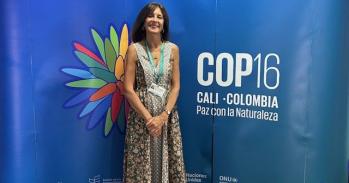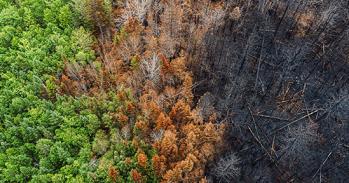
Thanks to ongoing research in the field, visitors to the Botanic Garden can experience the fascination of plant diversity and relate this to their understanding of our planet’s uniquely different habitats.
Thanks to ongoing research in the field, visitors to the Botanic Garden can experience the fascination of plant diversity and relate this to their understanding of our planet’s uniquely different habitats.
To be of core value to the activities and purpose of a botanic garden, the plant collections should ideally be of documented wild origin. Because of this, expeditions to collect authentic material from the field have always played a vital role.
Thanks to ongoing research in the field, visitors to the Botanic Garden can experience the fascination of plant diversity and relate this to their understanding of our planet’s uniquely different habitats.
The source or origin of a plant growing in the Cambridge University Botanic Garden (CUBG) may at first seem unimportant given that a vast range of ornamental plants is readily available through UK nurseries. But do these selections and hybrids meet the needs of CUBG as a botanic collection? To represent global plant diversity, we need to grow a much wider range of plants – sometimes unusual, not always ornamental and often of wild origin.
Call of the wild
Collections from the field are vital for research and to conserve species under threat in their native habitat, pending the development of appropriate re-introduction programmes. Some plants have survived only because of botanic garden collections. One of these, a grass known as interrupted brome (Bromus interruptus), used to be widespread in the arable fields of southern England, but improved seed cleaning and the use of herbicides led to its decline and final extinction in 1978. The last documented population was recorded in a field in Pampisford, near Cambridge. Thankfully, a plant survived in cultivation and CUBG was one of the few gardens that have ensured its survival. In a project led by the Royal Botanic Gardens at Kew, our Cambridge plants have now been propagated and re-introduced back into the wild in two locations.
To be of core value to the activities and purpose of a botanic garden, the plant collections should ideally be of documented wild origin. Because of this, expeditions to collect authentic material from the field have always played a vital role. As examples, CUBG collections of Alchemilla, Fritillaria, Geranium and Lavandula contain a very high proportion of wild-collected plants, making them a key research resource in unravelling the naming and relationships of the species.
The Cambridge collection of Lavandula, which is especially strong in wild-collected species from the Canary Islands and North Africa, enabled the definitive monograph of this genus to be published by Dr Tim Upson and Susyn Andrews in 2004. The collection also provided essential material for the beautiful botanical reference paintings of each species by Cambridge botanical artist Georita Harriott. The collection is now being used for further research into understanding the patterns and mechanisms of variation and speciation in the genus.
The way we go about collecting plant species in the wild became more complex following the 1992 Earth Summit, in which the sovereign right of a country over its genetic resources was recognised. Collecting material for potential commercial gain, such as prospecting for new medicinal compounds or ornamentals for the nursery market, now requires agreements to ensure financial benefits are fairly shared. Crucially, however, the Convention also recognised that maintaining access to wild material for the ‘common good’, such as education and research, is still important.
International collaboration is now prerequisite for undertaking a collecting expedition in the field. In recent years, CUBG has run two collaborative trips – to collect poppy and crocus species in particular – both of which have enhanced Cambridge collections and enabled the sharing of expertise, for mutual benefit.
Poppy project
Collaboration with the Institute of Botany in Yerevan, Armenia, was instrumental in setting up a plant-collecting trip to the country. Through a University College scholarship, Dr Anna Asatryan from the Institute spent six weeks at CUBG furthering her research on the oriental poppy, Papaver orientalis, an Armenian native. In September 2005, Dr Tim Upson and Sally Petitt joined her on a collecting trip around Armenia, where many ornamentals and important economic plants like wild wheats and apricots originated.
Armenia has only recently become accessible, so the wild collections made on this trip are probably the first for 60 years. It will be interesting to compare wild material of, for example, Achillea filipendulina, an imposing, architectural perennial, with cultivated material to see how the garden plant has changed over time. An exciting find was Clematis orientalis, which is widespread across Asia and bears attractive yellow flowers in summer. However, with its creamy petals spotted purple, the Armenian version was very different and we await its flowering here in Cambridge with anticipation.
Collecting crocus
CUBG has also been involved for several years in a collaborative project with the newly established Balkan Botanic Garden Kroussia (BBGK) in Greece. In October 2006, three members of staff participated in a collecting expedition with BBGK. The primary aim was to collect autumn-flowering Crocus hadriaticus and Crocus boryi on Kefalonia for the BBGK collection.
This highly rewarding expedition yielded not only both Crocus species on the wish-list, but also specimens of other Kefalonian endemics including Biarum tenuifolium and Colchicum parlatoris. CUBG staff also gained valuable field experience that enhanced understanding of habitats and growing conditions for application here, and specimens of the material collected in the field will soon augment the Balkan collection on the CUBG Rock Garden.
Sharing the collection
Although collecting wild plant material has greatly changed in recent times, continued access to plants growing in their native communities remains central to the CUBG mission to maintain and develop the plant collections for future generations, and to provide access to them for research, pleasure and learning. But today it is also about sharing, not just the plants, but also the enormous expertise and knowledge within the botanic garden community, for the benefit of all.
The expeditions to Armenia and Kefalonia were financed by the Anne and Philip Tallantire Expedition Fund. The Stanley Smith UK Horticultural Trust has also contributed vital support for the ongoing collaboration between CUBG and BBGK.
Glasshouse restoration
<div> <p>The Glasshouse Range at CUBG is currently undergoing a major restoration, thanks to the University’s Estate Management and Building Service. The original teak structure of the 1930s has been steam-cleaned, sanded, repaired and treated with teak oil before being entirely re-glazed. Any replacement timber components have been fashioned from teak reclaimed from the redundant Shippams Paste factory in Chichester.</p> <div>CUBG have taken the opportunity provided by the restoration to develop an overarching theme of ‘the drama of diversity’ that will see all the houses re-landscaped, re-planted and interpreted to explore how plants have evolved to survive in some of the key environments around the world – from icy mountains to oceanic islands, from desert to tropical rainforest. The Temperate House, the first to be restored and re-planted, is now home to ‘Continents Apart’, a display focusing on the Cape of South Africa and Southwestern Australia. Over three-quarters of all plants found growing here grow wild nowhere else on Earth.</div> <div></div> <div>Donarbon Ltd have generously funded the transformation with a £35,000 grant made through Evolve EB under the Landfill Tax Credit Scheme, and a key supporting grant of £5000 came from the Sustainable City programme of the Cambridge City Council.</div> </div>
This work is licensed under a Creative Commons Licence. If you use this content on your site please link back to this page.





